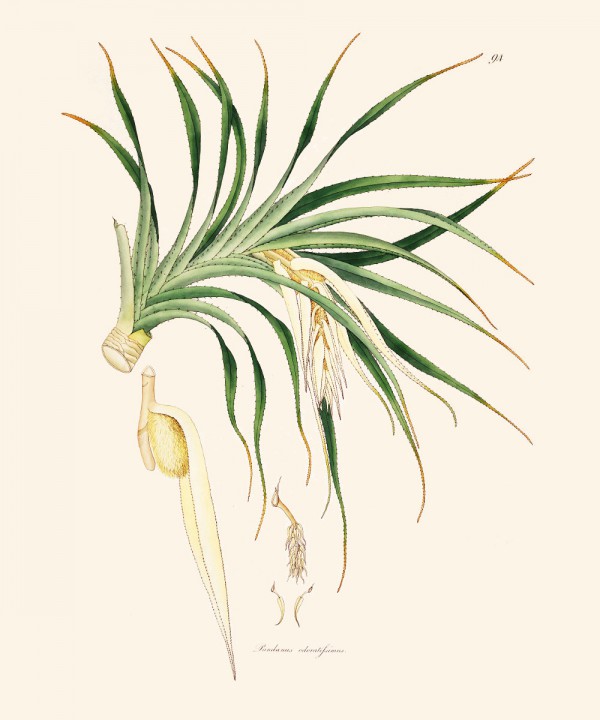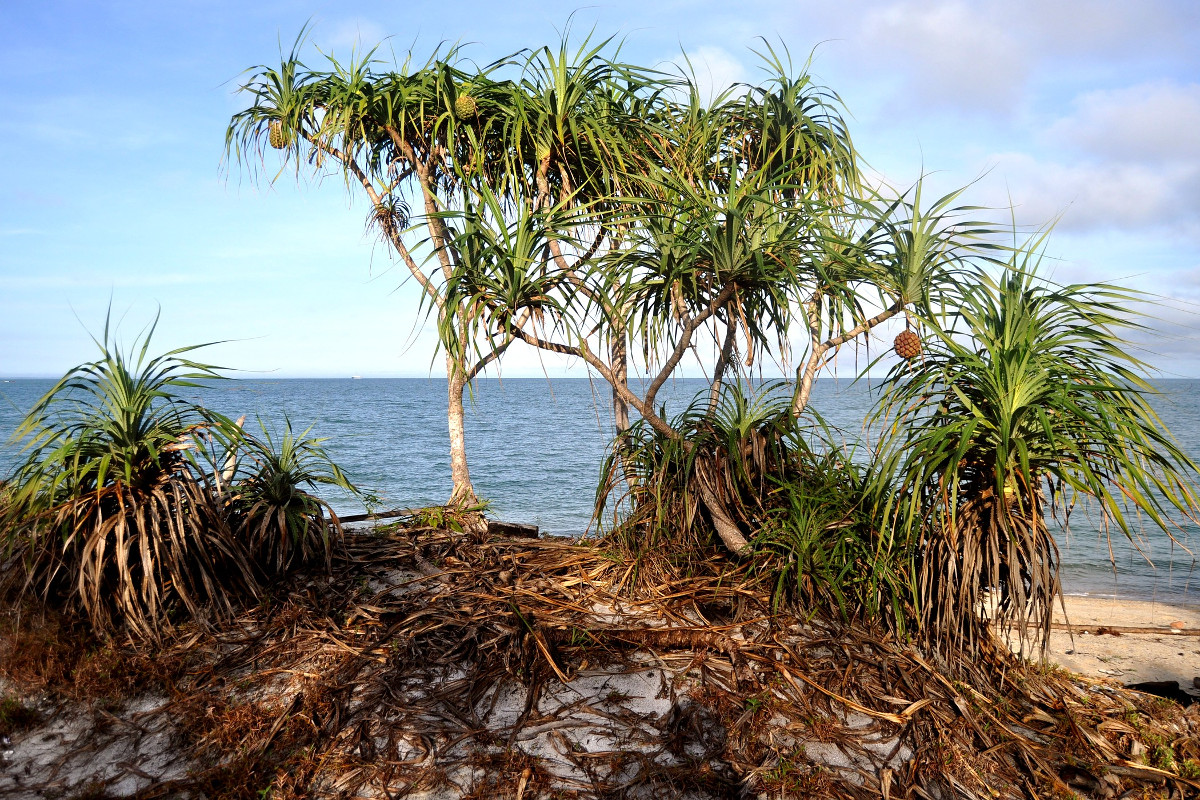Pandanus odorifer (Forssk.) Kuntze - syn.Keura odorifera Forssk. (basionym); Pandanus odoratissimus L.f.; Pandanus fascicularis Lam. - Pandanaceae
pandan laut (indones.), padang, fragrant pandan, kewda, Kewra, Wohlriechende Schraubenpalme
Dioecious stilt-rooted evergreen plant, up to 15m tall, native from from India to Indonesia, naturalized elsewhere (eastern Africa, Florida); stems greyish-brown, ringed with many leaf scars; rosette of leaves on top of the branches, sword-like; male flowers with yellow bracts, fragrant. wikipedia
„Kewra flowers have a sweet, perfumed odour with a pleasant quality similar to rose flowers, but kewra is more fruity. The aqueous distillate (kewra water, pandanus flower water) is quite diluted; it can be used by the teaspoon, often even by the tablespoon…
The distillations yields several grades of essences: Addition of sandalwood results in a product called attar kewra which is the common grade in perfumery; the pure, rather costly essential oil is known as ruh kewra. Kewra water is a cheap byproduct of hydrodistillation suited for culinary use. Flowers of lower quality, as are common during the dry season, can be processed into kewra water only.“
http://gernot-katzers-spice-pages.com/engl/Pand_odo.html
„…the fragrant male inflorescence is distilled in water and the vapour absorbed into sandalwood oil to make the perfume kewda attar.“
[Minter, Sue. The greatest glass house: the rainforests recreated. HMSO, 1990, 65]
„The chemical composition of the essential oils obtained by water distillation of the staminate inflorescences of Kewda (Pandanus fascicularisLam. var. fasicularis) and Ketaki (P.fascicularis Lam. var. Ketaki) are reported. The major components of kewda oil were found to be 2-phenylethyl methyl ether (65.6-75.4%), terpinen-4-ol (11.7-19.5%), p-cymene (1.0-3.1%) and α-terpineol (1.2-2.9%), while the major components of ketaki oil were 2-phenethyl methyl ether (66.2%), 4-hydroxy phenol (6.1%), 2-phenethyl alcohol (4.5%), 3-acetyl anisole (2.26%) and p-benzoquinone (1.3%).“
[Chemical composition of the essential oils of Kewda and Ketaki., Misra, R., Dash, P.K., Rao, Y.R., Journal of Essential Oil Research, 12(2), 2000, 175-178]
 2-phenylethyl methyl ether green floral |  α-terpineol pine lilac |  terpinen-4-ol woody mentholic |  2-phenylethanol sweet floral |
„The major components of the hydrodistilled kewda oil were 2-phenylethyl methyl ether (37.7%), terpinen-4-ol (18.6%), α -terpineol (8.3%) and 2-phenyl ethyl alcohol (7.5%), whereas the major constituents of kewda oil from the local market were 2-phenyl ethyl alcohol (33.2%), 2-phenyl ethyl methyl ether (16.1%), benzyl benzoate (11.0%), viridine (8.8%) and germacrene B (8.3%).“ Both oils contained also small amounts of eugenol (0.1-0.6%) and vanillin (trace-0.4%).
[Essential oil composition of ‘kewda’(Pandanus odoratissimus) from India., Raina, V.K., Kumar, A., Srivastava, S.K., Syamsundar, K.V., Kahol, A.P., Flavour and fragrance journal, 19(5), 2004, 434-436]
„Extraction of male spadices of kewda (Pandanus fascicularis Lam.) flowers with hexane furnished a waxy extract, the so-called ‘concrete’. Treatment of the extract with methanol gave a reddish oily residue (‘absolute’) with a smell strongly reminiscent of the aroma of kewda flowers… The methanol-soluble portion contains considerable quantities of fatty acids and their methyl esters, which function as a fixative for the volatile fragrant components of the extracts. While the recoveries of the oxygenated compounds terpinen-4-ol and α-terpineol are less than the amounts usually obtained through hydrodistillation, the major component, 2-phenyl ethyl methyl ether, and non-polar compounds, α-thujene, sabinene and its hydrate, have been obtained in larger amounts.“
[Extraction of kewda (Pandanus fascicularis Lam.) flowers with hexane: composition of concrete, absolute and wax., Rout, P.K., Misra, R., Sahoo, S., Sree, A., Rao, Y.R., Flavour and fragrance journal, 20(4), 2005, 442-444]
„P.odorifer, which supports the local perfume industry by the perfume extracted from the male inflorescence, is cultivated in the Ganjam district of Orissa, India (Panda et al., 2007, 2009). It is estimated that about 35 million flowers (3500 tons) are processed annually to produce fragrance and flavour materials worth Rs. 400 million (US$ 8.9 million) (Anonymous, 1996)… The study reveals the fragrance potential of P.thwaitesii, P.kaida and P.palakkadensis, which could be xploited commercially for extraction of essential oil.“
[Collection, characterization and olfactory evaluation of Pandanus species in Southern India., Zanan, R.L., Nadaf, A.B., Plant Genetic Resources, 11(01), 2013, 84-86]

Roxburgh, W., Plants of the coast of Coromandel, vol.1 t.94 (1795)
http://plantgenera.org/species.php?id_species=741740

Pandanus odorifer (with fruits of female trees), southern Bangka Island, Indonesia, © Wibowo Djatmiko CC BY-SA 3.0 wikimedia
